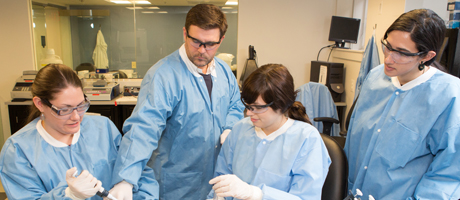Forensic laboratories are often plagued with a backlog of evidence related to sexual assault cases. Currently, the only way to test the presence of semen is the microscopic observation of spermatozoa, a time-consuming process that involves forensic analysts spending hours looking at slidea through a microscope. To accelerate the process and decrease the margin for error, Assistant Professor of Forensic Sciences Daniele Podini has been awarded a two-year, $263,313 grant from the National Institute of Justice to test a faster, cost-effective, and automated method for the identification of spermatozoa called Proximity ligation real-time Polymease chain reaction (PLiRT-PCR).
PLiRT-PCR is a molecular, analytic procedure that enables detection and quantitation of a target protein, in this case, sperm specific proteins. Detection of these proteins will serve as a confirmation for the presence of spermatozoa and enable faster, more efficient processing of sexual evidence.
“This method will allow forensic laboratories to process more cases, reduce backlog, and ultimately increase public safety,” said Podini. “In addition, it will expose our students to cutting-edge research in the forensic DNA field, making them better scientists and better DNA analysts once they start working.”
The grant will support the project for two years, funding the hire of student research assistants and the purchase of reagents—compounds used in the processing and identification of the protein samples. The preliminary work that enabled the generation of sufficient data for a successful proposal was performed by Michelle Peck, MS ’12, now employed as a research DNA technician at the Armed Forces DNA Identification Laboratory.
Peck was taking Podini’s forensic biology class and working as a graduate research assistant in his lab when the idea for the PLiRT-PCR project began taking shape. They used the method to detect prostate-specific antigen (PSA), which is found in seminal fluid, and developed a lab procedure, called an assay, to detect sperm specific proteins.
“Our success with some of the sperm specific proteins was essential in showing that PLiRT-PCR was a valid technique and that it was worth more in-depth investigation to develop an assay to detect sperm,” explained Peck.
Continuing and expanding on the work begun by Peck are graduate students Jaclyn Stopczynski, Lori Prugh, and Caitlin Ayoub. “We have been working on the initial testing with the PLiRT PCR method, developing the optimal parameters for the method using two different sperm specific proteins,” noted Stopczynski.
Those parameters include temperature variation, protein blocker additions, cross reactivity with other body fluids, and testing using a variety of samples, such as liquids, cotton swabs, and cloth samples. In addition, the team is looking into identifying different sperm specific proteins as possible targets for testing.
“The new method we’re using combines immunological, molecular biology, and PCR methods that I was familiar with, but had never thought of using together,” said Prugh. “The quantitative PCR data that we generate is already used in forensic labs, though for different applications.”
“I immensely enjoy working as part of this team,” added Ayoub. “My time spent with Professor Podini on this research project has been the most rewarding of my graduate school experiences.”
And, assuming this automated method for analyzing sexual evidence proves effective, the ultimate reward will be in bringing swifter justice to sexual predators.


